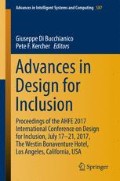Abstract
This paper presents a work in progress, that is part of a Post-Doctoral Research and aims to develop and test a new chromatic planning methodology for urban furniture. This methodology records all environmental colors from a chosen settlement in order to establish its dominant colors and, consequently, make it possible to define the urban furniture colors, which should make a chromatic and luminosity contrast with the environment. Simultaneously, this contrasting color application to urban furniture will enable its elements to stand out from their background, transforming them in inclusive factors as they become more visible for people with vision difficulties. The urban furniture chromatic planning will, also, contribute for the local identification and, in big cities where all the neighborhoods may have each one color for its urban furniture, it will ameliorate the city orientation. In this case study, the chosen settlement – Bucelas – is a small rural town near Lisbon.
Access this chapter
Tax calculation will be finalised at checkout
Purchases are for personal use only
Notes
- 1.
Art of color.
References
Minah, G.: Memory constellations: urban color and place legibility from a pedestrian view. In: AIC Color 05 – 10th congress of the International Color Association, Granada, Spain, pp. 401–404 (2005)
Baines, P., Dixon, C.: Signs, Lettering in the Environment, p. 14. Laurence King Publishing Ltd, London (2003)
Costa, J.: Señalética: de la senalización aldiseño de programas, p. 182. Ediciones CEAC, SA, Barcelona (1987)
Berger, C.: Wayfind: Designing and Implementing Graphic Navigational Systems, p. 121. Rotovision SA, Switzerland (2005)
Mollerup, P.: Wayshowing, p. 161. Lars Müller Publishers, Baden (2005)
Itten, J.: Art de la Couleur (Kunst der Farbe), p. 144. Dessain et Tolra, Paris (1985)
Gamito, M.: Cor no Mobiliário Urbano: um factor de inclusividade, orientação e identificação, unpublished Ph.D. thesis, Faculdade de Arquitetura da Universidade de Lisboa, Lisbon (2012)
Albers, J.: La interacción del color, p. 13. Alianza Forma, Madrid (1989). (1st publication: 1963. Yale University)
Michael Lancaster, M.: Colourscape. Academy Editions, London (1996)
Machnow, H., Reuss, W.: Farbe im Stadtbild, p. p21. Abakon Verlagsgesellschaft mbH, Berlin (1976)
Creus, M.: Spaces furniture and urban elements. In: Serra, J. (eds.) Elementos Urbanos, mobilário y microarquitectura. p. 6. Editorial Gustvo Gili, Barcelona (2000)
Barker, P., Barrick, J., Wilson, R.: Building Sight, a handbook of building and interior design solutions to include the needs of visually impaired people, pp. 7–51. Royal National Institute for the Blind (RNIB), London (1995)
Acknowledgments
The present study was developed with the support of CIAUD – Research Centre in Architecture, Urbanism and Design, Faculty of Architecture, University of Lisbon, and FCT − Fundação para a Ciência e Tecnologia.
Author information
Authors and Affiliations
Corresponding author
Editor information
Editors and Affiliations
Rights and permissions
Copyright information
© 2018 Springer International Publishing AG
About this paper
Cite this paper
Gamito, M., Sousa, J. (2018). Urban Furniture’s Chromatic Planning Methodology: Bucelas, a Case Study. In: Di Bucchianico, G., Kercher, P. (eds) Advances in Design for Inclusion. AHFE 2017. Advances in Intelligent Systems and Computing, vol 587. Springer, Cham. https://doi.org/10.1007/978-3-319-60597-5_31
Download citation
DOI: https://doi.org/10.1007/978-3-319-60597-5_31
Published:
Publisher Name: Springer, Cham
Print ISBN: 978-3-319-60596-8
Online ISBN: 978-3-319-60597-5
eBook Packages: EngineeringEngineering (R0)

